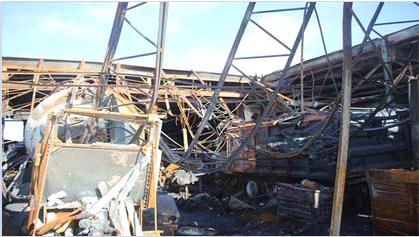Fire Effects on Steel
The Effects of Fire on Structural Steel
After a fire involving a building or industrial structure, there are often multiple types of damage to the building materials. An understanding of the mechanical and physical properties of the building materials and the effects that heat has on those properties are important aspects of the damage assessment. Knowing how heat affects various building materials can be helpful in determining the level of damage to building components.
What Happens When Steel is Exposed to Fire?
Structural Steel can regain close to 100 percent of its pre‐heated properties if the temperature does not exceed 720°C (1330°F). Structural steel typically consists of hot-rolled, low carbon steel of varying strength. The properties of such steels change with increasing temperature. As the steel temperature increases the following can occur:
- Corrosion
- Dimensional changes
- Reduction of strength
- Permanent changes in the steel microstructure

Corrosion
During a fire, protective coatings like paint are often consumed. Surface corrosion will then form on the exposed steel surfaces. Rust results from oxidation of the steel, a chemical reaction, which is temperature-dependent. Exposure to elevated temperatures in a fire can cause thermally enhanced oxidation of the steel.
In addition, the gases created by fire often contain chlorides and other potentially corrosive chemicals from melted plastics and other materials. If there is reason to expect chlorides or any other fire generated aggressive corrodents, any corroded steel should be visually examined to determine if the cross-section has been adversely affected. Surface testing for the level of chlorides can be conducted.
Dimensional Changes
As temperatures rise, steel expands due to thermal expansion. Unless other factors are present, these changes are temporary. If the steel is restrained during the fire, then internal stresses may be induced in the steel components that can create buckles or other permanent deformations.
Reduction of Strength
As the temperature of the steel increases above room temperature, the strength of the steel decreases:
- At 204°C (400°F), carbon steel retains approximately 90 percent of its yield strength.
- At 427°C (800°F), it retains approximately 60 percent of its yield strength.
- At 566°C (1050°F), carbon steel only retains approximately 50 percent of its yield strength.
The loss of strength due to elevated temperatures is often temporary.
Permanent Changes in the Steel Microstructure
If heated to sufficiently elevated temperatures, between 704°C (1300°F) and 843°C (1550°F) for most structural steel, and rapidly cooled by suppression water during firefighting operations, some of the steel's microstructure will be transformed into martensite. Martensite is a hard, but brittle phase of steel. If the exposure temperature of the steel is less than the temperature at which this transformation takes place, then the mechanical properties of the steel essentially return to their pre‐fire values after cooling, depending on the time of exposure and cool down rate.
The lack of deformation in a loaded condition is a visual clue that the steel was not heated to a temperature sufficient to result in the formation of martensite during the fire, and as a result, the steel's mechanical properties were probably not altered by the fire.
If any of the above issues are noted on structural steel after a fire, an engineer should be engaged to evaluate the steel and determine if it should be replaced.
In our next blog, we will discuss the effects of fire on concrete, and methods that can be used to evaluate the effects of fire on various structural members.

